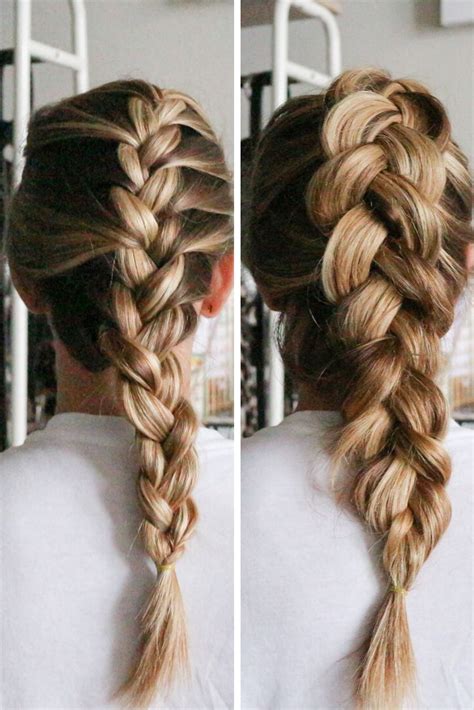Introduction
Whether you’re an aspiring hair stylist or a seasoned enthusiast, mastering the art of French and Dutch braids is essential for crafting stunning and intricate hairstyles. While both techniques create woven plaits, they exhibit distinct characteristics that set them apart. This comprehensive guide will delve into the nuances of each braid, exploring their similarities, differences, and practical applications.

French Braid: A Classic Cascade
French braids are characterized by their effortless elegance and subtle appearance. The braid is created by dividing the hair into three strands and gradually adding hair from the sides as you weave them together. The resulting braid lies flat against the head, creating a sleek and polished look.
Key Features of French Braids:
- Origin: France
- Appearance: Flat, smooth, and tight
- Effort Level: Moderate
- Best Suited For: Medium to long hair
Step-by-Step Guide to French Braiding:
- Brush your hair to remove any tangles.
- Divide your hair into three equal strands at the crown.
- Cross the right strand over the middle strand.
- Cross the left strand over the new middle strand (now the former right strand).
- Repeat steps 3 and 4, gradually adding small strands of hair from the sides as you braid.
- Continue braiding until you reach the nape of your neck.
- Secure the end of the braid with an elastic band.
Dutch Braid: A Bold Statement
Dutch braids, also known as “inverted French braids,” exude a bolder and more voluminous appearance. The technique involves creating an inside-out version of the French braid. Instead of adding hair from the sides over the middle strand, you cross the strands under the middle strand. This results in a raised and prominent braid that stands out from the head.
Key Features of Dutch Braids:
- Origin: Netherlands
- Appearance: Raised, textured, and chunky
- Effort Level: Moderate to advanced
- Best Suited For: All hair types
Step-by-Step Guide to Dutch Braiding:
- Brush your hair to ensure it’s tangle-free.
- Divide your hair into three equal strands at the crown.
- Cross the left strand under the middle strand.
- Cross the right strand under the new middle strand (now the former left strand).
- Repeat steps 3 and 4, gradually adding small strands of hair from the sides as you braid.
- Continue braiding until you reach the nape of your neck.
- Secure the end of the braid with an elastic band.
Similarities and Differences Between French and Dutch Braids
Similarities:
- Both French and Dutch braids involve dividing the hair into three strands.
- They both utilize a weaving technique to create a series of interlaced sections.
- They can be styled in various ways, such as buns, ponytails, or updos.
Differences:
| Feature | French Braid | Dutch Braid |
|---|---|---|
| Weaving Direction | Strands crossed over the middle strand | Strands crossed under the middle strand |
| Appearance | Flat and subtle | Raised and textured |
| Difficulty Level | Moderate | Moderate to advanced |
| Best Suited Hair Type | Medium to long | All hair types |
Practical Applications of French and Dutch Braids
French and Dutch braids offer versatile styling options for various occasions:
- Everyday Wear: French braids are ideal for keeping hair out of the face while adding a touch of sophistication. Dutch braids provide a bolder and more eye-catching look for casual outings.
- Formal Events: Both French and Dutch braids can elevate any formal attire, creating a polished and elegant hairstyle.
- Sports and Activities: French and Dutch braids are practical for keeping hair secure and away from the face during physical activities.
- Wedding Hair: Braids are a popular choice for brides, as they can be styled in intricate and stunning updos for the special day.
Customer Validation: Engaging Questions
To ensure customer satisfaction, hair stylists should ask the following questions:
- What kind of occasion are you preparing for?
- Do you prefer a sleek and subtle look or a more prominent and textured style?
- What hair type do you have?
- Have you ever had a French or Dutch braid before?
Common Mistakes to Avoid
- Tension Too Tight: Avoid braiding the hair too tightly, as this can cause discomfort and hair breakage.
- Uneven Strands: Ensure that the three strands you divide your hair into are equal in width to maintain a balanced and even braid.
- Incomplete Weaving: Make sure to weave all the hair into the braid and avoid leaving any loose strands.
- Frizz: Use a hairspray or serum before braiding to smooth flyaways and reduce frizz.
- Lack of Practice: Mastering French and Dutch braids takes practice. Don’t be discouraged if your first attempts aren’t perfect.
Conclusion
French braids and Dutch braids are both elegant and versatile hair-styling techniques that add beauty and practicality to any look. By understanding the key differences between them, hair stylists can create tailored hairstyles that meet the specific needs and preferences of their clients. With practice and a keen eye for detail, hairstylists can master both braiding techniques to create stunning and memorable looks.
